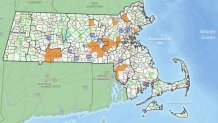
The spotted lanternfly continues to pop up in Massachusetts.
The little insect is not as frightful as another invasive species that recently showed up in Massachusetts, the palm-sized Joro spider that's now in Boston, but it's considered much worse for the environment — spotted lanternflies leave behind a substance that promotes a plant-killing mold. Many authorities urge people to kill the pests on sight, if possible.
WATCH ANYTIME FOR FREE
Stream NBC10 Boston news for free, 24/7, wherever you are. |
This year, spotted lanternfly infestations have been reported in communities across Massachusetts, including Framingham, Lawrence, Lynn, Marlborough, Norton and more, according to the state's Department of Agricultural Resources, which keeps a map that tracks sightings.

Get updates on what's happening in Boston to your inbox. Sign up for our News Headlines newsletter.
Milbury announced a confirmed infestation this week, writing, "We are encouraging residents and businesses to use the attached guides to learn more about this pest and report any spotted lanternfly sightings to the following link: massnrc.org/pests/slf or call 617-626-1779."
Meanwhile, spotted lanternflies are so prevalent in nearby Connecticut that officials have told residents to stop reporting them — though they shouldn't stop killing the insects.
“They’re in all the counites in Connecticut at this point,” state scientist Gale Ridge told NBC Connecticut last month. “They’re running along the interstate corridors.”
This fall, in a bid to prevent spotted lanternflies from taking up residence in the Boston Harbor Islands, federal and state conservation workers are removing more than 100 of a favorite spotted lanternfly tree, the tree-of-heaven, which, like the spotted lanternfly, is native to Asia.
"Tree-of-heaven is too tasty a tree (to spotted-lanternflies) to risk having around," the National Park Service said in an article on the project on Bumpkin Island, which it called a first.




